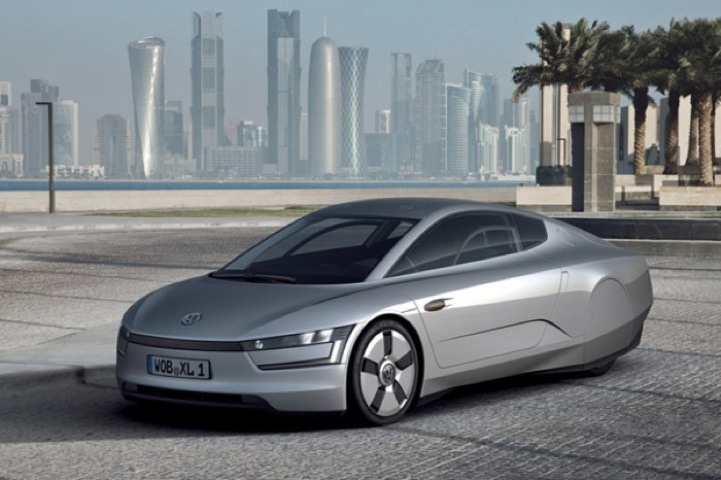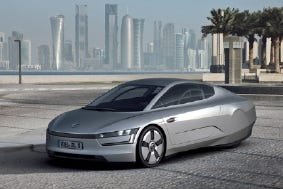Meeting European Union emission targets of 120 g of CO2/km by 2015 and 95 g/km for 2020 is a top priority for Volkswagen AG (Wolfsburg, Germany), which expects to become the world's number two automaker in terms of output this year behind General Motors, turning out 8 million vehicles. At the recent JEC Asia composites show and conference held in Singapore, Armin Plath, Head of Materials Research and Manufacturing Processes at VW outlined some of the challenges that lie ahead.
October 24, 2011

Meeting European Union emission targets of 120 g of CO2/km by 2015 and 95 g/km for 2020 is a top priority for Volkswagen AG (Wolfsburg, Germany), which expects to become the world's number two automaker in terms of output this year behind General Motors, turning out 8 million vehicles. At the recent JEC Asia composites show and conference held in Singapore, Armin Plath, Head of Materials Research and Manufacturing Processes at VW outlined some of the challenges that lie ahead.
|
260 mpg realized in concept car through combination on drive technology, aerodynamics, and lightweighting. |
Plath noted that the company's BlueMotion technology centered on diesel engines and optimized transmissions had gone a long way to delivering on the 2008 target of 140 g/km but moving forward, vehicle lightweighting would play a major role in further reductions in conjunction with alternative drive technologies, eventually leading to battery-powered vehicles in 2050 with emissions of just 20 g/km. This target is more than achievable according to Plath given VW has almost achieved this with its XL1 PHEV concept driven by a 0.8-L diesel engine mated to a 20-kW electric motor. The 795-kg (1750 lb.) vehicle also features lightweight construction (monocoque and components made of carbon fiber composites) and a low aerodynamic drag (Cd = 0.186). The combination realize incredible fuel economy of 0.9 l/100 km (260 mpg) and emissions of 24 g/km. The two-seater XL1 PHEV debuted at the 2011 Qatar Motor Show in January this year.
Plath notes that 36% of fuel consumption in a fossil fuel-powered vehicles is wholly or partially dependent on mass, and that a 100-kg reduction in mass can reduce CO2 emissions by 8.4 g/km. Conversely, over the 34 years between the debut of the Golf Mark I in 1975 and the Mark VI in 2009, the vehicle's weight as increased from around 800 kg to approximately 1200 kg. "A lot of this has to do with safety requirements and greater comfort levels," says Plath. "The challenge now is to reduce vehicle weight, but at an acceptable cost."
CFRP price pressure
Lightweight materials such as carbon fiber composites have been used in VW vehicles including the Bugatti Grand Sport, Audi R8 Spyder, Lamborghini Aventador, and Bentley Mulsanne but needless to say cost is generally not an issue for owners and manufacturers of such cars. "The break-even cost for carbon fiber composites is 10 EUR/kg if we want to employ such materials extensively in a Golf," says Plath, quoting data from aluminum components supplier Martinrea Honsel GmbH (Meschede, Germany). This compares with 450 EUR/kg for civil aviation and 40,000 EUR/kg for space applications.
"The major limitation [of carbon fiber composites] is cost, both from a materials and processing perspective. We feel enabling the use of thermoplastics will be important, and indeed required for large-scale production," says Plath. "Current RTM processes are only suitable for 50,000 parts per tool per year, whereas thermoplastic hot pressing or injection molding processes would enable 300,000 parts per year in 1-3 minute cycles."
Plath's areas for action are aiming for a reduction in carbon fiber reinforced composite (CFRP) costs by about 50%, a reduction in processing costs by approximately 90%, a 70% reduction in the cost of painting CFRPs, and importantly a reduction in CO2 emissions over the entire life cycle of the CFRP materials themselves by around 55%. Currently, production of 1 kg of carbon fiber emits 40 kg of CO2 and Plath is thus urging the carbon fiber industry to improve its production efficiencies by, for example, using alternative heating technologies such as plasma or microwaves, and consider alternative raw materials such as lignin.
In summary, Plath sees a mix of steel, aluminum, magnesium, CFRP and other reinforced plastics such as those employing long glass fibers as most likely offering a financially attractive construction. "We have a log way to go to achieve sustainable lightweighting," he concludes.-[email protected]
You May Also Like



